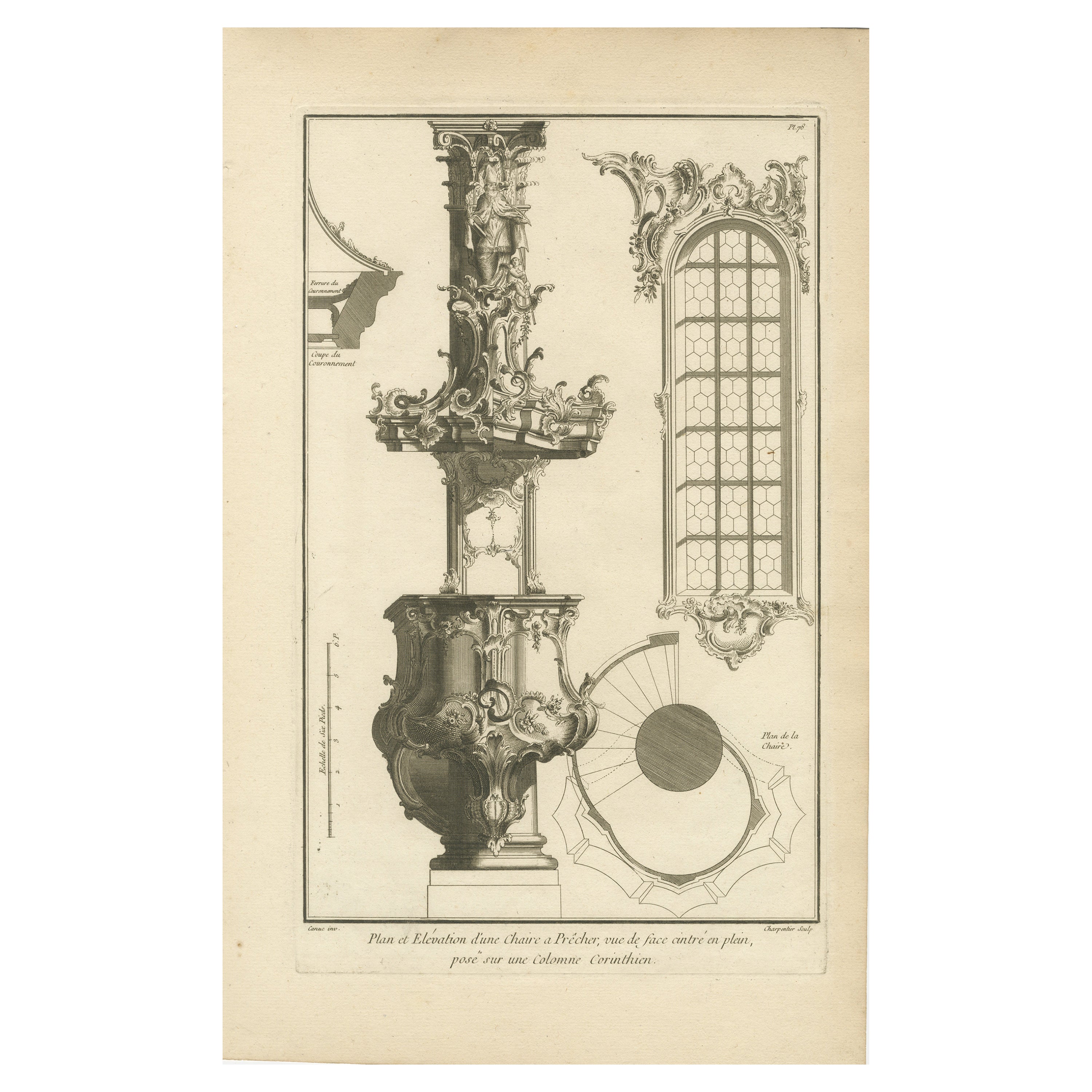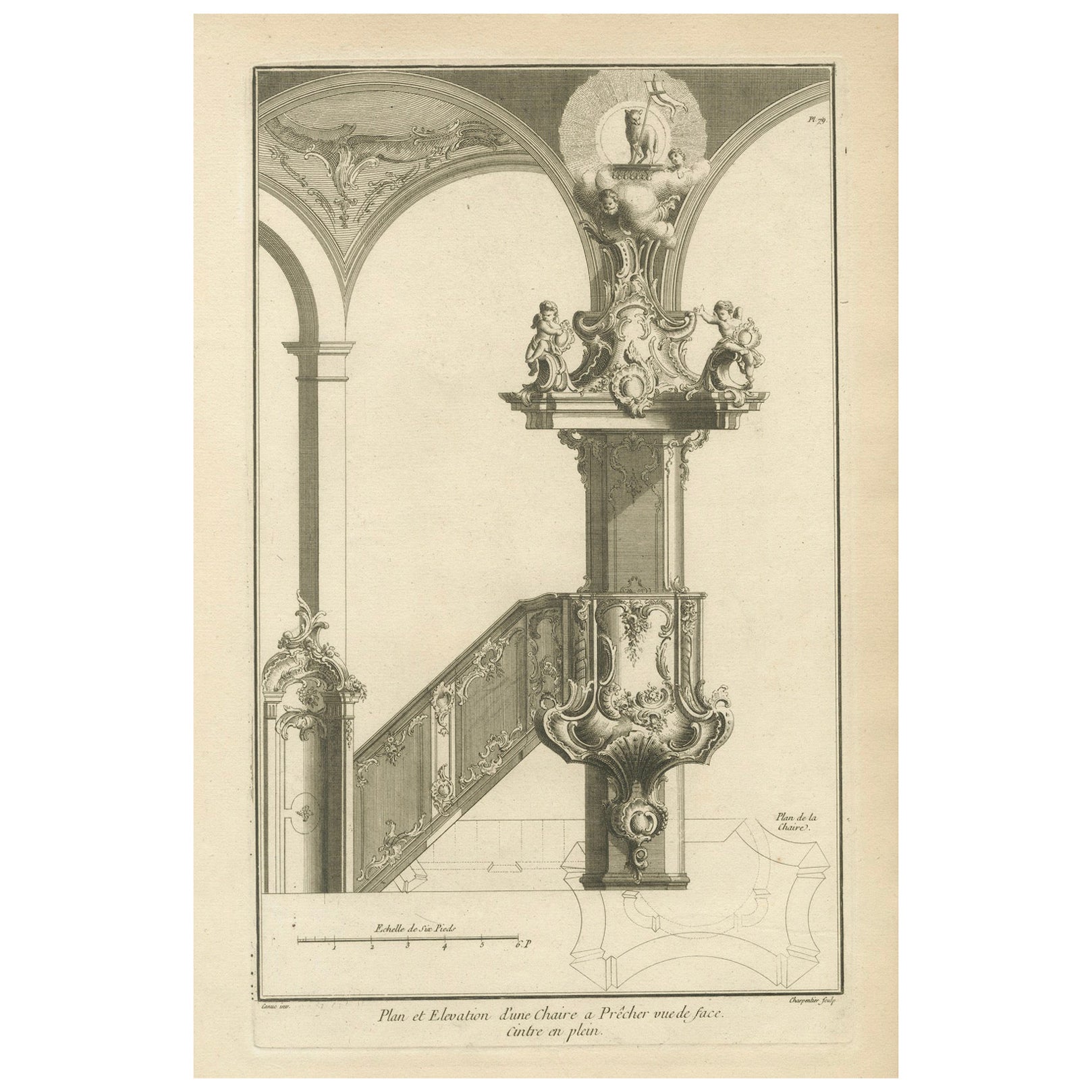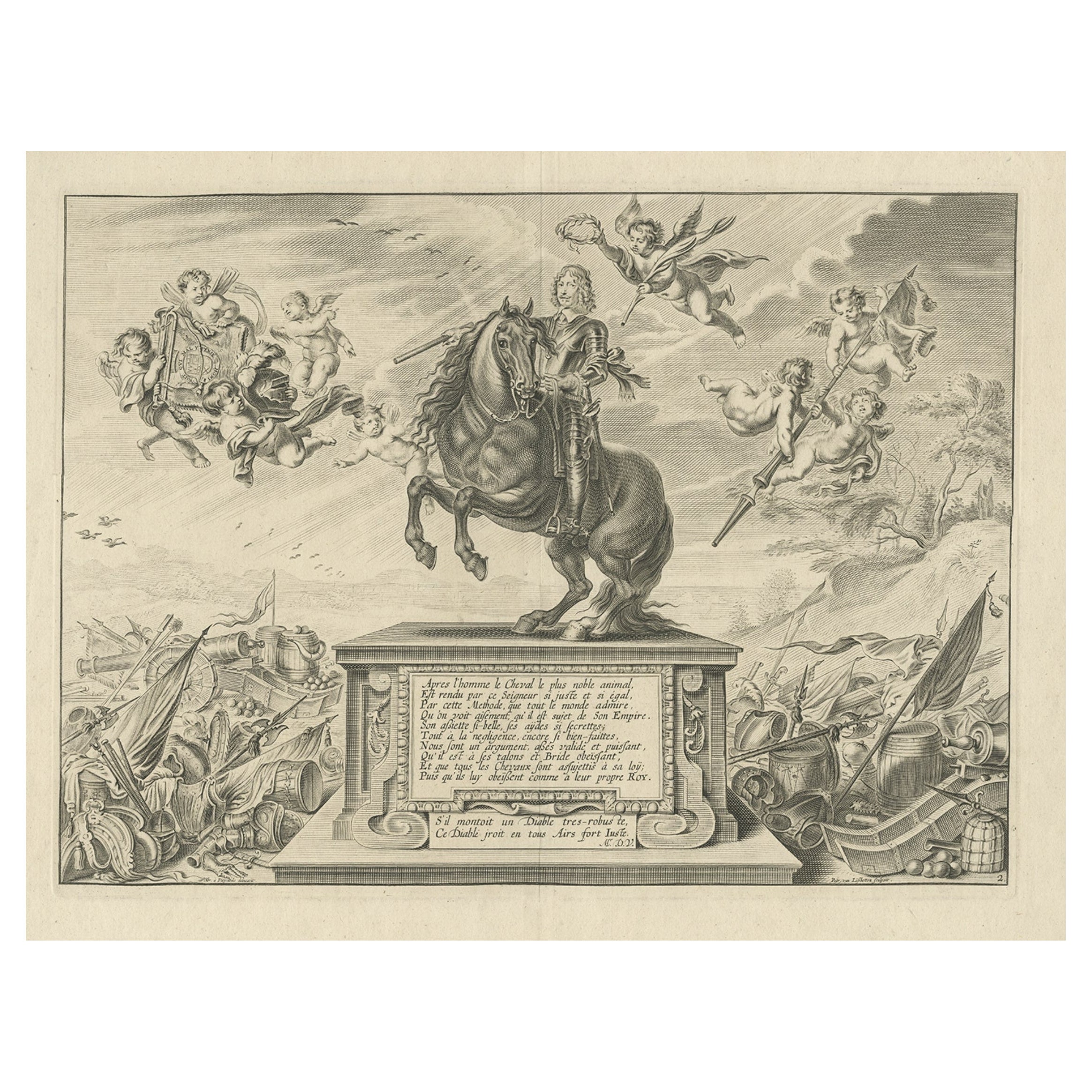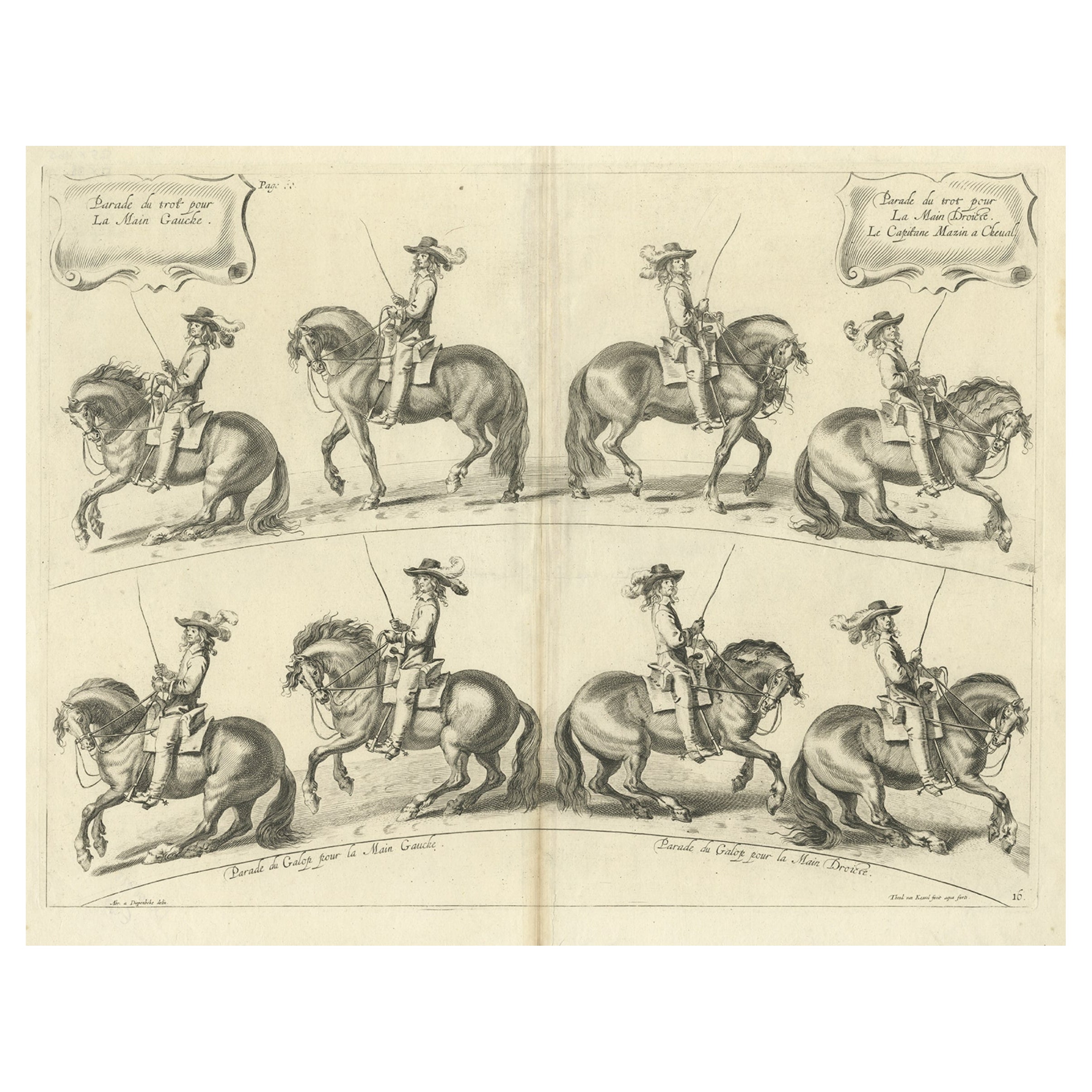Items Similar to Architectural Print of a Rococo Pulpit Elevation on a Corinthian Column, ca.1740
Want more images or videos?
Request additional images or videos from the seller
1 of 6
Architectural Print of a Rococo Pulpit Elevation on a Corinthian Column, ca.1740
About the Item
This is an original antique architectural design for a rococo pulpit dating approximately between 1740 and 1760.
The artist responsible for this design is Franz Xaver Habermann, and it was published by Johann Georg Hertel I in Augsburg. The design shows a richly decorated pulpit, typical of the Rococo style, which is known for its elaborate ornamentation, asymmetry, and curves. This image is one of four numbered plates related to this work. The detail in the engraving is meticulous, showcasing the elaborate aesthetic that characterized much of the European art and architecture during the mid-18th century.
Franz Xaver Habermann (1721–1796) was a German engraver and etcher who was active during the 18th century, a period marked by the Rococo style. Although not as widely known as some of his contemporaries, Habermann contributed significantly to the graphic arts during his time.
Habermann's work often featured architectural designs, such as the intricate pulpit depicted in the image you've provided. He was skilled in creating prints that detailed elaborate decorative schemes and architectural fantasies, which were popular during the Rococo period. His creations were known for their intricate details and the fluidity of their lines, capturing the lightness and ornamental excesses that characterized Rococo design.
Johann Georg Hertel I, who published Habermann's work, was part of a notable family of engravers and publishers in Augsburg, a city that was an important center for publishing in Europe at the time. The Hertel family played a significant role in disseminating artistic and architectural designs through their publications.
While specific details about Habermann’s life and training may not be as well-documented as those of major artists of his time, his surviving works suggest that he was a highly skilled engraver who had mastered the Rococo style, contributing to the spread of this aesthetic through his printed works. His designs would have influenced the tastes of the period, both within Germany and across Europe, where the appetite for such elaborate designs was significant.
More in detail about this engraving:
The text on the print is French, and it translates to English as:
"Elevation of a pulpit from the front with a full arch, placed on a Corinthian column."
This description refers to the architectural drawing of the pulpit, indicating that the design features a frontal view of the pulpit with an arch and that it is supported by a column in the Corinthian order, which is known for its ornate capitals decorated with acanthus leaves and scrolls.
In our shop we also published the other three engravings in this series and they might still be on offer as well.
- Dimensions:Height: 16.54 in (42 cm)Width: 10.44 in (26.5 cm)Depth: 0 in (0.02 mm)
- Materials and Techniques:Paper,Engraved
- Period:1740-1749
- Date of Manufacture:circa 1740
- Condition:Good, given age. Light soiling near paper edges. Light staining. Left paper edges a bit rough from binding. Very light creasing from handling. General age-related toning and/or occasional minor defects from handling. Please study scan carefully.
- Seller Location:Langweer, NL
- Reference Number:
About the Seller
5.0
Platinum Seller
These expertly vetted sellers are 1stDibs' most experienced sellers and are rated highest by our customers.
Established in 2009
1stDibs seller since 2017
1,948 sales on 1stDibs
Typical response time: <1 hour
- ShippingRetrieving quote...Ships From: Langweer, Netherlands
- Return PolicyA return for this item may be initiated within 14 days of delivery.
More From This SellerView All
- Old Baroque Pulpit Design with Corinthian Column and Staircase Plan, ca.1740Located in Langweer, NLArchitectural design with the central elements depicted in the engraving: the Baroque design of the pulpit, the inclusion of a Corinthian column which suggests a classical influence, and the presence of a staircase plan indicating the approach to the pulpit. Dating approximately between 1740 and 1760. The artist responsible for this design is Franz Xaver Habermann, and it was published by Johann Georg Hertel I in Augsburg. The design shows a richly decorated pulpit and archway, typical of the Rococo style, which is known for its elaborate ornamentation, asymmetry, and curves. This image is one of four numbered plates related to this work. The detail in the engraving is meticulous, showcasing the elaborate aesthetic that characterized much of the European art and architecture during the mid-18th century. Franz Xaver Habermann (1721–1796) was a German engraver and etcher who was active during the 18th century, a period marked by the Rococo style. Although not as widely known as some of his contemporaries, Habermann contributed significantly to the graphic arts during his time. Habermann's work often featured architectural designs, such as the intricate pulpit depicted in the image you've provided. He was skilled in creating prints that detailed elaborate decorative schemes and architectural fantasies, which were popular during the Rococo period. His creations were known for their intricate details and the fluidity of their lines, capturing the lightness and ornamental excesses that characterized Rococo design. Johann Georg Hertel I, who published Habermann's work, was part of a notable family of engravers and publishers in Augsburg, a city that was an important center for publishing in Europe at the time. The Hertel family played a significant role in disseminating artistic and architectural designs through their publications. While specific details about Habermann’s life and training may not be as well-documented as those of major artists of his time, his surviving works suggest that he was a highly skilled engraver who had mastered the Rococo style, contributing to the spread of this aesthetic through his printed works. His designs would have influenced the tastes of the period, both within Germany and across Europe, where the appetite for such elaborate designs was significant. More in detail about this engraving: This engraving features a detailed representation of a Baroque-style preacher's pulpit, intricately designed and placed upon a Corinthian column, demonstrating the grandeur of religious architecture during the Baroque period. The pulpit is richly adorned with elaborate scrollwork, acanthus leaves, and possibly religious iconography, all common elements in Baroque ecclesiastical design. A significant feature of this print is the inclusion of architectural details such as the Corinthian column base, known for its ornate capital with acanthus leaves and scrolls, which supports the pulpit above. This classical element signifies stability and order, providing a stark contrast to the exuberant decoration of the pulpit itself. To the right of the pulpit, there's a tall, slender window filled with panes that could either be clear or stained glass, framed by an ornate window arch...Category
Antique 1740s Prints
MaterialsPaper
- Baroque Pulpit Elevation with Ornate Archway and Balustrade Engraved, ca.1740Located in Langweer, NLThis is an original antique architectural design for a pulpit in baroque style with archway and balustrade dating approximately between 1740 and 1760. The artist responsible for th...Category
Antique 1740s Prints
MaterialsPaper
- Original Antique Baroque Sermon Pulpit with Full Arch Elevation, circa 1740Located in Langweer, NLThis is an original antique architectural design for a pulpit in baroque style dating approximately between 1740 and 1760. The artist responsible for this design is Franz Xaver Hab...Category
Antique 1740s Prints
MaterialsPaper
- Old Print of William Cavendish, First Duke of Newcastle, on Horseback, ca.1740Located in Langweer, NLAntique print titled 'Apres l'homme le Cheval (..)'. Antique print depicting William Cavendish, first Duke of Newcastle, on horseback on an inscr...Category
Antique 1740s Prints
MaterialsPaper
- Antique Architectural Elevation of Sandon Hall, Staffordshire in England, c.1770Located in Langweer, NLAntique print titled 'Principal Front of Sandon'. Architectural elevation of Sandon Hall, Staffordshire. This print originates from 'Vitru...Category
Antique 1770s Prints
MaterialsPaper
- Original Antique Print of a New Way of Dressing or Schooling of Horses, ca.1740Located in Langweer, NLAntique horse print titled 'Parade du trot pour La Main Gauche'. Antique print depicting the schooling of horses. This print originates from 'Methode et Invention Nouvelle de Dresser les Chevaux' by W. Cavendish. Artists and Engravers: Engraved by T. van Kessel.Category
Antique 1740s Prints
MaterialsPaper
You May Also Like
- Architectural Etching, Gaines 'Columns'Located in Montreal, QuebecArchitectural print Total of 6 available 2 horizontal & 4 vertical prints Dimensions: Frame: 16” W x 20.25” H x 1” D Etching: 9.5” W x 13.75” H.Category
Antique Late 19th Century French Neoclassical Prints
MaterialsWood, Paper
- Architectural Etching, Gaines 'Columns'Located in Montreal, QuebecArchitectural print Total of 6 available 2 horizontal & 4 vertical prints Dimensions: Frame: 16” W x 20.25” H x 1” D Etching: 9.5” W x 13.75” H.Category
Antique Late 19th Century French Neoclassical Prints
MaterialsWood, Paper
- Set of Three Neoclasssical Architectural PrintsLocated in West Palm Beach, FLThis stylish three piece set of neoclassical architectural elements will make a statement with their polychrome colorations, and their black and gold frames. Note: Mat opening dimen...Category
Late 20th Century Italian Neoclassical Revival Prints
MaterialsGlass, Giltwood, Paper
- Four Large Architectural Prints of Classical OrdersLocated in Richmond, LondonA set of four very decorative large prints of architectural orders, 20th century, after Sir William Chambers (1723-1796) from his Treatise on Civil Architecture published in 1759. I...Category
Mid-20th Century English Classical Greek Prints
MaterialsPaper, Paint
- Italian Spolvero Rococo Print on Canvas Framed with Citrine CrystalsBy InteriLocated in Dublin, Dalkey18th century Italian spolvero fresco pattern printed onto canvas and framed with a custom frame and citrine crystals. Spolvero is an artistic method of transferring a design from a ...Category
Antique 18th Century Italian Rococo Prints
MaterialsRock Crystal
- Italian Spolvero Rococo Print on Canvas with an Antique FrameBy InteriLocated in Dublin, Dalkey18th century Italian spolvero fresco pattern printed onto canvas and framed with an antique wood frame. Spolvero is an artistic method of transferring a design from a print to the p...Category
Antique 18th Century Italian Rococo Prints
MaterialsAsh, Canvas, Wood, Paper





